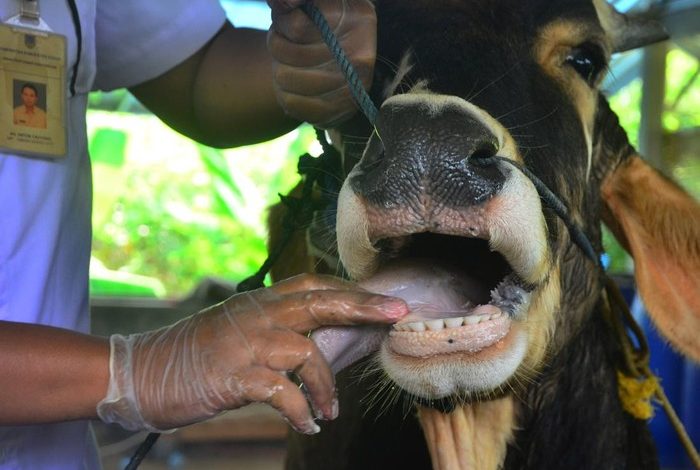Detection of Foot and Mouth Disease Virus in Cattle: RT-PCR Study in Banyuwangi, East Java

Detection of Foot and Mouth Disease Virus in Cattle: RT-PCR Study in Banyuwangi, East Java
Overview of Foot and Mouth Disease Virus (FMDV)
Foot and Mouth Disease Virus (FMDV) poses a significant threat to cloven-hoofed animals due to its high transmission rate. The World Organisation for Animal Health (OIE) categorizes FMDV as an infectious animal disease, reporting a 100% morbidity rate among affected populations. Mortality rates can reach as high as 20-30% in young animals, with adult mortality typically ranging from 1-5%. In Southeast Asia, including Indonesia, outbreaks of FMDV are common. The initial recorded outbreak in Indonesia occurred on April 28, 2022, with 1,247 cases reported in East Java and 1,881 cases in Aceh Tamiang District, Aceh Province. This situation prompted the Indonesian Minister of Agriculture to declare specific outbreak areas in East Java and Aceh.
Characteristics of FMDV
FMDV, belonging to the genus *Aphthovirus* within the Picornaviridae family, comprises seven serotypes: O, A, C, SAT-1, SAT-2, SAT-3, and Asia1, each exhibiting genetic and antigenic diversity. The virus particles measure 25-30 nm and have an icosahedral capsid containing a positive-sense single-stranded RNA genome, which encodes four structural proteins and several non-structural proteins. The VP1 gene is critical for receptor binding and is utilized in the development of amplification and sequencing primers for FMDV detection.
The O/ME-SA/Ind-2001 lineage of FMDV, first identified in India in 2001, has expanded to various regions, including Southeast Asia, with the O/ME-SA/Ind-2001e sub-lineage being particularly prevalent in Indonesia and neighboring countries.
Study Overview
A study focused on detecting FMDV in beef cattle based on clinical symptoms, employing the reverse transcriptase-polymerase chain reaction (RT-PCR) method, followed by sequencing. The objective was to provide vital data to inform policymaking and control measures aimed at reducing the impact of FMD.
Materials and Methods
In August 2022, samples were collected from cattle diagnosed with FMD, which exhibited symptoms such as fever and oral vesicles. Vesicle swabs from the mouth and feet of cattle in smallholder farms in Banyuwangi, East Java, were preserved in Phosphate Buffer Saline with a 5% antibiotic transport medium and stored at -80°C prior to analysis.
Viral RNA extraction was carried out using the QIAmp Viral RNA Mini Kit according to the manufacturer’s instructions. The isolated RNA was eluted in RNase- and DNase-free water and also stored at -80°C.
RT-PCR was conducted to detect and genotype FMDV using the one-step RT-PCR Takara Kit. This involved applying universal primers for initial detection, followed by the use of specific primers for serotype O targeting the VP1 gene. A conventional PCR machine facilitated the temperature cycling conditions necessary for amplification.
Results and Discussion
The RT-PCR tests confirmed FMDV infection in the livestock, employing a universal primer set for rapid initial detection, which produced expected product sizes indicating positive results. The universal primer set demonstrated efficacy consistent with previous studies. Additionally, the use of serotype O-specific primers successfully detected the presence of FMDV.
RT-PCR methods are acknowledged for their sensitivity and specificity in identifying FMDV outbreaks. The discrepancies in results between universal and serotype-specific RT-PCR indicated a higher effectiveness of universal primers in identifying infections.
The VP1 protein of FMDV functions as a principal capsid protein and antigenic determinant, essential for evoking a neutralizing antibody response. This study underscored the significance of universal primers for effective rapid diagnosis and urged the development of local isolate-specific primers to enhance detection sensitivity.
FMD outbreaks were last reported as being under control in Indonesia in 1990. However, the resurgence of cases in 2022 has raised concerns, with associations made between the spread of the virus and meat imports as well as illegal animal entries. Timely recognition and diagnosis of FMD are crucial for effective management of outbreaks.
Ultimately, this study affirms that the RT-PCR technique can accurately detect FMDV in cattle from smallholder farms in Banyuwangi, East Java. The findings indicate that universal primers are more sensitive than serotype-specific primers, highlighting the importance of ongoing genetic surveillance of FMD viruses in Indonesia for effective management and control strategies. Future research endeavors are recommended to prioritize genetic analyses of field isolates to monitor the evolution of FMD viruses.
Source: Zayyin Dinana




